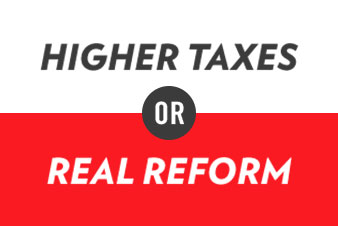Media

What to Know about the Senate Budget
Late last night, the Senate unveiled its version of the spending side of a state budget. The Senate advanced the bill from the Appropriations Committee with a full floor vote expected early Friday morning, giving lawmakers just a few hours to review the $32 billion spending plan.
The proposal remains unbalanced, reportedly relies on borrowing and maybe higher taxes (policies that created our budget crisis), and leaves questions about structural reforms unanswered.
The budget isn’t balanced
Based on this budget and the latest revenue forecast, the year will end with a $1.6 billion deficit, and lawmakers need approximately $500 million in new revenue to pay for next year's spending list. The Pennsylvania Constitution requires a balanced budget. Passing a spending bill without a plan to pay for it violates the constitutional requirement for a balanced budget.
There is no “agreed to” plan to balance the budget, much less legislation passed by both the House and Senate to generate revenue whether via borrowing, expanded gambling, liquor privatization, or transfer of other funds.
Passing a spending plan without a plan to pay for it will result either in pressure to make bad decisions, like job killing tax hikes, or in another deficit. Or both, as was the case with the current budget.
Spending increase over last year's enacted budget exceeds TPA
- The Senate budget represents $32.0 billion in General Fund spending next year. This is an increase in spending of $216 million over the House budget passed in April.
- The budget bill includes a whopping $400 million in supplement appropriations for 2016-17—spending above and beyond the $31.5 billion budget passed last June. This increase is entirely due to cost overruns in Human Services. The governor's proposed budget and the House budget included only $234 million in supplemental spending.
- With these supplementals, the actual 2016-17 budget deficit represents nearly $1.6 billion–that is how much taxpayers owe in unpaid bills to start the new fiscal year.
- The proposed spending exceeds the limit embodied in the Taxpayer Protection Act (TPA) by nearly $100 million. The TPA index represents the average growth of population and inflation (1.16%) applied to last year's enacted budget.
What’s in the revenue plan?
Last year the legislature passed a budget (which Gov. Wolf let become law without his signature) before passing a revenue plan. That didn't turn out well. The revenue package eventually included $650 million in tax increases–including an e-cigarette tax that resulted in nearly 100 vape shops closing, a liquor modernization proposal that didn’t deliver, gambling revenue that never happened, and a proposed loan that was blocked by litigation.
- Borrowing? There’s a good chance to expect that the “revenue” package will include borrowing against future revenue—most likely from the tobacco settlement fund.
- Severance Tax? Legislative leaders indicate an additional natural gas severance tax isn't on the table. Yet many groups, including government unions and political groups funded by unions, are ramping up their pressure for a severance tax. If there isn't an agreement on a revenue package, it's impossible to really say what won't be in it.
- Gambling? Expanded gambling has been a hot topic in the capitol, but there's no agreement on that either. Lawmakers could vote for a limited expansion of casino gambling. Or they may pass video gambling in bars. It's possible we end up without any gambling expansion. We don’t know, because there is no agreement.
- Drink Tax? Another rumored tax increase would increase what bars charge on alcoholic drinks. Assessing the sales tax on the retail price of alcoholic drinks at bars and restaurants punishes small businesses, and simply takes more from the pockets of patrons.
Will the final budget include structural reforms?
- Merger of Corrections & Parole: The budget includes line items for the Department of Corrections and Probation and Parole in one single, unified department. Yet enabling legislation to do this hasn't passed yet.
- Medicaid reforms: Early news stories about the budget indicate some savings and reforms in Human Services (the largest department) and specifically in Medicaid–the largest single driver of state spending growth. Yet those reforms have to be ironed out as part of the welfare code, which hasn't happened yet.
Departmental increases
- Restores virtually all of the House reductions in corporate welfare in the DCED budget.
- Increase of $40 million in spending on Agriculture from the House budget.
- $430 million increase in K-12 education spending from last year.
- $280 million reduction in Human Services spending over last year's spend (after the aforementioned supplementals were added), $200 million less than the House budget, and $500 million less than Gov. Wolf proposed.
- $15 million increase in the legislative budget.
What lawmakers need to do
While much of what could happen to build a revenue package will be bad for taxpayers and consumers, there are real solutions being considered that would close the budget gap without demanding one penny more from hardworking Pennsylvanians.
- Reduce handouts for politically-selected corporations.
- Let grocery stores sell liquor. Privatizing alcohol sales would not only increase revenue, but reduce PLCB costs.
- Prioritize all spending, including the billions of dollars outside the General Fund. Bringing some of those other funds back into the General Fund budget would close the deficit without taking more for working families.
- Adopt meaningful long-term welfare reforms. If we are to put our fiscal house in order, addressing the long-term growth while improving the quality of programs must be a top priority. Putting meaningful work requirements in the welfare code would promote both fiscal responsibility and independence.